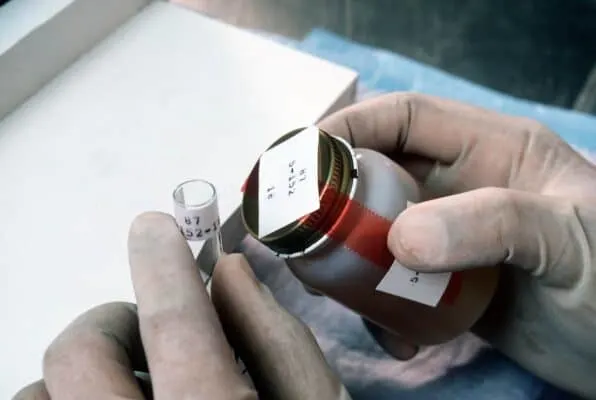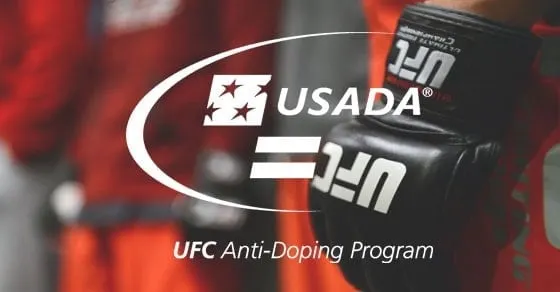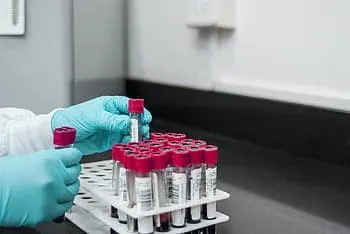The UFC has strict policies when it comes to drug testing. It really doesn’t matter if a fighter is a champion or an up-and-coming fighter, the rules are the same for all. The UFC puts a lot of effort and resources into keeping the sport clean and they are testing all fighters multiple times per year. But, have you ever asked yourself how UFC drug testing works?

UFC fighters get tested for various banned substances both in and off competition. Since 2015, the UFC has been cooperating with the biggest anti-doping agency called USADA. This agency handles the testing, analyzes the results and punishes the fighters if they violate the rules.
They test UFC fighters for various substances like:
- anabolic steroids
- growth hormones
- estrogen blockers
- narcotics
Keep reading this article to find out more about how UFC is testing the fighters. We will go deep into what substances are not allowed and how often UFC fighters get tested.
Do UFC Fighters Get Drug Tested?
Yes, all UFC fighters get tested for Performance-Enhancing Drugs(PEDs). Since 2015, the UFC has been cooperating with the U.S. Anti-Doping Agency (USADA) with the goal to keep the sport clean. USADA agents will first plan the testing, select the fighter, and then collect urine or blood samples. If the results are positive for PEDs, USADA will punish the fighter by giving them long suspensions. How long the fighter will stay out of the sport really depends on the type of violation.
The UFC fighters get randomly tested for PEDs multiple times per year on average. USADA performs a minimum of 2,750 tests per year, which is around five tests per fighter, per year. But bear in mind that some fighters get tested more than others.
But one thing is for sure, the UFC and USADA spend a lot of resources on testing fighters as much as they can. They are ready to do all to increase the chances of catching the fighters taking PEDs. USADA doesn’t care where the fighter is training or living at that moment. USADA agents will travel all around the world to test fighters at any time and in any place.
It doesn’t matter if a fighter is sleeping, eating dinner with friends, or has a meeting with their sponsors. They must take a break and provide a sample to USADA officials.
The UFC may ask its fighters to undergo extra tests performed by the state athletic commission. If the UFC event takes place in Texas, for instance, the athletic commission from this state has the right to ask for additional testing.
Can UFC Fighters Refuse a Drug Test?
No, UFC fighters are not allowed to refuse a drug test. They must provide urine and blood samples whenever USADA agents show up. In the case they fled from a test, fighters will receive a long suspension. And from what we have seen thus far, refusing a test is not worth the length of a suspension.
When USADA notifies a fighter that they have been selected for testing, fighters can delay it. But they can do this only if they have a valid reason for it. Training or media work are not valid reasons to avoid drug testing.
In UFC history, there have been a couple of fighters who tried to run away from USADA tests. One of the most famous fighters who tried to do this was Wanderlei Silva. In 2014, Silva fled a random drug test ahead of his bout against Chael Sonnen at UFC 175. Silva would later admit that he had run away from a test because he was taking diuretics. As a result, he got a three year suspension from the competition.
When Did UFC Start Cooperating with USADA?
USADA became a part of the UFC’s anti-doping program in 2015. It all started on June 3 when the partnership between these two organizations became public. This was the first time in the history of MMA that the world-leading anti-doping agency would test the MMA fighters. The UFC tested its fighters for PEDs before. But, this was nowhere near as strict and serious as the way USADA is doing testing.

Before the test started, USADA spent the first couple of months just educating the fighters about PEDs and how the testing would look like in the future. They traveled all around the world to visit the most famous MMA gyms and educate both coaches and fighters. Once they did that, USADA started testing athletes in October 2015.
In some way, the arrival of USADA into the sport of MMA marks the beginning of a new era. It changed the image of the UFC, which was no longer seen as barbaric. Thanks to USADA, UFC has gained tremendous credibility of becoming a mainstream sport like NFL or NBA.
This also helped the MMA to become legal in all U.S. states, and the UFC to sign many TV deals. The biggest one was, of course, the one with the largest sports network, ESPN.
If you are a UFC fan, it is worth knowing more details about how USADA affects UFC fighters.
How Does USADA test for PED?
The USADA testing protocol starts as soon as the fighter signs with the UFC. Once they become a part of the promotion, they enter the testing pool as well. This means that USADA can collect the samples and test the fighter whenever they want. They can ask for blood and urine samples while fighters are both in and out of competition.

It’s important to note that the process of testing differs between the urine and blood samples. Here is all you need to know about how does USADA tests UFC fighters for PEDs.
- The first step is to plan a test and select a fighter
- USADA doping control officer (DCO) will notify the fighter in person about the testing.
- Athletes can’t run away or avoid testing. They can delay the process but only if they have a valid reason for it.
- Athletes must remain in a seated position for 20 minutes prior to the blood draw.
- The DCO will collect the blood sample and provide any after-care measures.
- The DCO will then put blood samples (tubes) in a security bottle and complete the paperwork with the fighter.
- Once they get the blood sample, the officer will ship it to a WADA laboratory for further tests.
- USADA officials can collect urine samples both in and out of competition. They can even do it on fight night without any advanced notice. The DCO will notify the athletes in person.
- An athlete must select a sealed sample collection vessel and inspect it to be sure that it has not been tampered.
- Fighters must provide at least 90ml of the urine sample under the direct observation of DCO. It’s important to note that a DCO must have a clear view of a fighter filling in the vessel.
- Next, the athlete will choose the security bottle in which DCO will put in the urine sample. Both parties must check the code numbers and inspect the bottles before placing B and A samples into the bags.
- Athletes and DOC will complete the paperwork and ship the samples to the WADA laboratory.
What Substances are Banned in UFC?
The USADA has a very strict policy on prohibited substances. There is a clear list of banned substances each fighter has to be aware of. Here is all you need to know about it.
Non-approved substances
- Anabolic agents — are the male sex hormone. Athletes take this hormone by injecting it into the muscle to increase testosterone levels. This hormone increases muscle strength and helps the body to recover from injuries.
- Growth factors — is a group of proteins that boosts the growth of specific tissues. Athletes use it to recover from joint, tendon, or muscle injuries.
- Beta-2 agonists– athletes use it to treat various respiratory diseases like asthma.
- Hormone and metabolic modulators- this substance can speed up or slow down the specific enzyme reactions. In most cases, MMA fighters use it to stop the effects of anabolic steroids.
- Diuretics and masking agents- diuretics help MMA fighters to cut weight more efficiently. And they use masking agents to hide the effects of other banned substances, such as anabolic steroids.
Substances prohibited in competition
- Stimulants– athletes use stimulants to enhance their performance in various ways. In most cases, they use it to enhance aggression and motivation. One of the most famous stimulants is the “amphetamine”
- Narcotics– in most cases, athletes use narcotics to suppress the pain from intense training or injuries.
- Cannabinoids– help fighters relieve stress and mental exhaustion from intense training.
- Glucocorticoid– resembles cortisol. Athletes use it to treat injuries, pain, asthma, and many other diseases.
In addition, you can read more about what is banned/illegal in the UFC.
What Substances are Allowed in UFC?
Although USADA has strict policies, UFC fighters can take legal supplements, vitamins or medication to keep their bodies strong and healthy. Or, they can take various medications to treat injuries or a specific disease.
But, each supplement or medicine they take must be off the USADA list of prohibited substances. Here is a list of some of the substances UFC fighters are allowed to use. If you want to learn more, you can check the entire list here:
- Antibiotics
- Anesthetics
- Antacids
- Antidepressives
- Ear drops
- Heart medications
- Contraceptives
- Pain relievers such as Aspirin
- Sleeping pills
- Various Cold and Allergy medications.
How many UFC Fighters Have Failed PED Testing?
USADA started testing UFC fighters in 2015 and in the first six months, their agents tested 353 fighters. Between 2015 and 2016, USADA got 35 positive test results for banned substances. One of the most famous UFC fighters who failed PED testing during that time was the former champ, BJ Penn. Over the years, the UFC roster got bigger and USADA increased the number of tests as a result.
If we move to 2020, USADA tested 720 UFC fighters and they did it across the 48 different countries. And we also have to point up that 89% of the tests were out of competition. In total, USADA did 3,230 urine tests and 327 blood tests, which is 3,557 tests in total for 2020. They issued 21 sanctions out of which most were for anabolic agents. Some of the most famous fighters who failed a drug test in 2020 are Jamahal Hill and Luis Pena.
Who is the Most Tested UFC Fighter?
One of the fighters who got tested the most is Paulo Costa. The Brazilian joined the UFC in 2017, and in the next four years, the USADA tested him over 60 times. This means that Costa had to provide blood and urine samples 15 times per year on average.
The other fighter who got tested a lot is the former UFC champ, Holly Holm. The USADA tested Holm over 60 times since joining the UFC roster in 2015, 10 times per year on average. If you want to find out more about how often UFC fighters get tested, you can check each athlete HERE.
Do UFC Fighters Get Tested for Diseases?
Yes, UFC fighters do get tested for various diseases as these tests are a part of the “MMA fighter package”. In fact, keeping fighters safe and healthy is very important to the UFC. MMA is a brutal sport where just about every match includes deep cuts and severe bleeding. In some matches, we can see the blood flying all over the cage, even spraying the people sitting beside it.
If just one fighter has a serious infection, they can spread it on the opponent or people sitting beside the cage. To keep the fighters safe from various diseases, UFC tests its fighters for:
- HIV
- Hepatitis C
- Hepatitis B
The Most Famous UFC Fighters Who Tested Positive for Steroids
Over the years, many famous UFC fighters have failed PED tests. Since 2015, we saw many legends of MMA who failed drug tests and getting long suspensions as a result. Some of the most famous are:
- Jon Jones — is the most dominant UFC champ in history who has failed drug tests many times in his career. The first time, he tested positive for cocaine after the UFC 182. Then, he tested positive for cocaine once again just days before the UFC 200 event. In 2016, his results came out positive once again, but this time for Turinabol, for which he got a 15-month suspension.
- Anderson Silva– is often seen as one of the best fighters in history. But, he tested positive for anabolic agents just a few days after his bout against Nick Diaz at UFC 183. In fact, Silva tested positive for two different anabolic steroids, which was a serious violation. And the same tests showed that he used banned sleeping pills. In 2015, he received a one year suspension and had to pay a $380,000 fine.
- TJ Dillashaw– is the former UFC 135lbs champ. In 2019, he tested positive for EPO shortly after losing his bout against Henry Cejudo. In his own words, Dillashaw took EPO on purpose, and he received a 15-month suspension for that.
Can UFC Fighters Use Recreational Drugs?
As of 2021, UFC fighters can use recreational drugs such as marijuana. The UFC changed its policy and will no longer punish the fighters who use this drug. This was a big change because, in the past, we saw many fighters getting long suspensions. The best instance is Nick Diaz who received 5 year suspension for testing positive for marijuana.
UFC fighters don’t have to worry about this anymore, but, they have to be careful. Marijuana is risk-free as long as they are not using it to enhance their performance in a fight. Or in other words, fighters can’t use it on fight night. As for other drugs, the USADA prohibits most of them.
